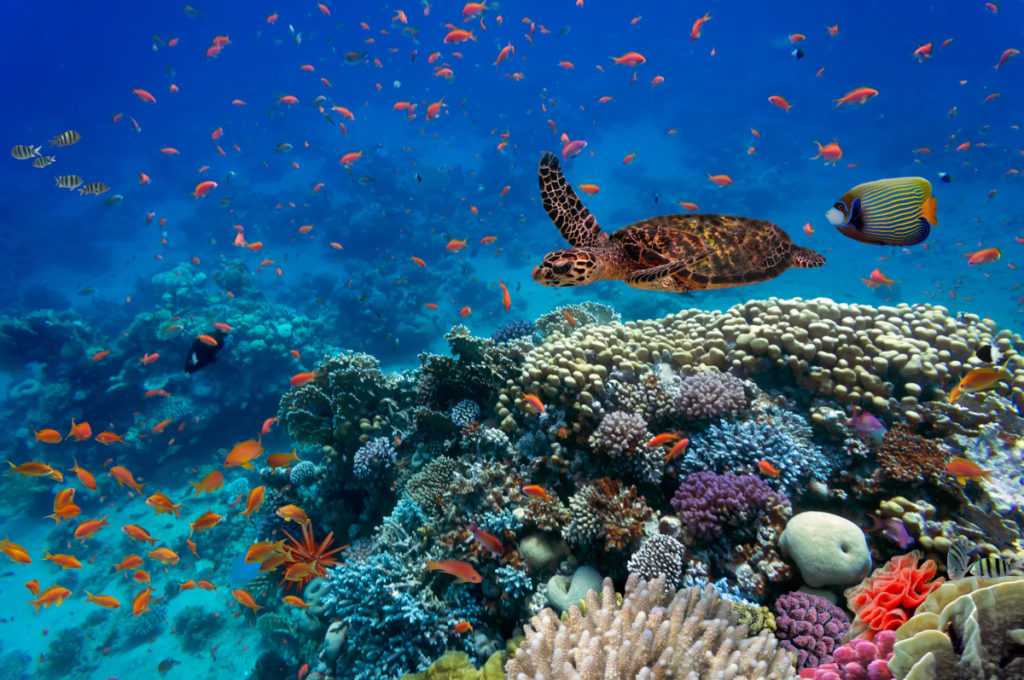
Biodiversity embraces the variety of genes, species and ecosystems that constitute life on Earth. Humankind is itself a part of biodiversity and our existence would be impossible without it. It is what makes our planet not only habitable but beautiful!
It is estimated that there are 8.7 million animal and plant species that inhabit our planet and approximately 2.2 million live in our marine environment, with only about 14% and 9% of the species on land and in the oceans respectively, classified1Mora C., Tittensor D.P., Adi S., Simpson A.G.B. & Worm B. (2011), How Many Species Are There on Earth and in the Ocean?. The loss of biodiversity in ecosystems, species and genes, is of concern not just because of the important intrinsic value of nature, but also because it results in a decline in “ecosystem services”. These services include production of food, fuel, fibre and medicines, regulation of water, air and climate, maintenance of soil fertility, cycling of nutrients. In this context, concern for biodiversity is integral to sustainable development and underpins competitivity, growth and employment, and improved livelihoods.
Recognition of the importance of maintaining and protecting biodiversity has been acknowledged at a highly political level for decades:
The adoption of the Convention on Biological Diversity at the United Nations Conference on Environment and Development (Rio de Janerio, 1992) received 168 signatures. It signified a global response to the commitment of sustaining and recognition of the importance of maintaining and protecting biodiversity. These goals have been acknowledged at a highly political level for decades.
The European Union (EU) agreed in 2001 “to halt the decline of biodiversity in the EU by 2010” and to “restore habitats and natural systems”2EU Commission, Environment: EU Biodiversity Action Plan.
At the 6th Conference of the Parties to the Convention on Biological Diversity (CBD), 191 nations committed themselves ‘to achieve by 2010 a significant reduction of the current rate of biodiversity loss at the global, regional and national level as a contribution to poverty alleviation and to the benefit of all life on Earth3Convention on Biological Biodiversity, Strategic Plan for the Convention on Biological Biodiversity – Decision VI/26
The United Nations General Assembly declared 2010 as the International Year of Biodiversity4Secretariat of the Convention on Biological Diversity, United Nations General Assembly Resolutions on the CBD, Resolution 61/203 and encouraged the increase of worldwide awareness on biodiversity and its importance
194 signatories met in Nagoya, Japan to set Aichi Biodiversity Targets (20 measurable targets), under the Strategic Plan for Biodiversity 2011 – 2020.
The EU acknowledging the objectives outlined in 2001 had not been achieved adopted a new strategy to halt biodiversity loss and degradation of ecosystems by 2020. Moreover, by 2050 biodiversity and the ecosystem services it provides – its natural capital – are protected, valued and appropriately restored5The EU Biodiversity Strategy to 2020.
While the importance of maintaining and protecting our biodiversity has been addressed and some progress made the pace and extent of implementation has been insufficient.
A 2019 Global Assessment completed by the Intergovernmental Science – Policy Platform on Biodiversity and Ecosystem Services (IPBES), presents the current situation as very seriously grave. The most comprehensive evaluation to date, involving 145 experts from 50 countries, concludes that currently approximately 1 million species are at risk of extinction within decades; the highest number estimated during the human history6UN Report: Nature’s Dangerous Decline “Unprecedented”; Species Extinction Rates Accelerating. Key findings of the report were:
However grim the outlook appears, the assessment did highlight some important progress
These actions, demonstrate and provide hope that with the implementation of effective conservation measures, biodiversity losses can be reduced. However, it is clear from the most recent assessment that such actions are needed now and should be implemented on a global scale.
Also promising is the recent 2019 Eurobarometer survey of more than 27,000 individuals. The survey revealed an increase in the public awareness and understanding of the term ‘Biodiversity’, from the 2015 survey7Government Europa, 2019 Biodiversity Eurobarometer reveals EU-wide concern. Over 90% of individuals agreed that humans must take responsibility to protect natural resources that are essential for building resilience against climate change and that EU’s sustainable development was dependent on biodiversity conservation.
Marine Biodiversity
EU Biodiversity Indicators – assessing achievement of the 2010 target at European level
Progress towards the European 2010 biodiversity target
WWF Living Planet Report 2020 – Through multiple indicators including the Living Planet Index (LPI), provided by the Zoological Society of London (ZSL), it shows an average 68% fall in almost 21,000 wildlife populations between 1970 and 2016.


